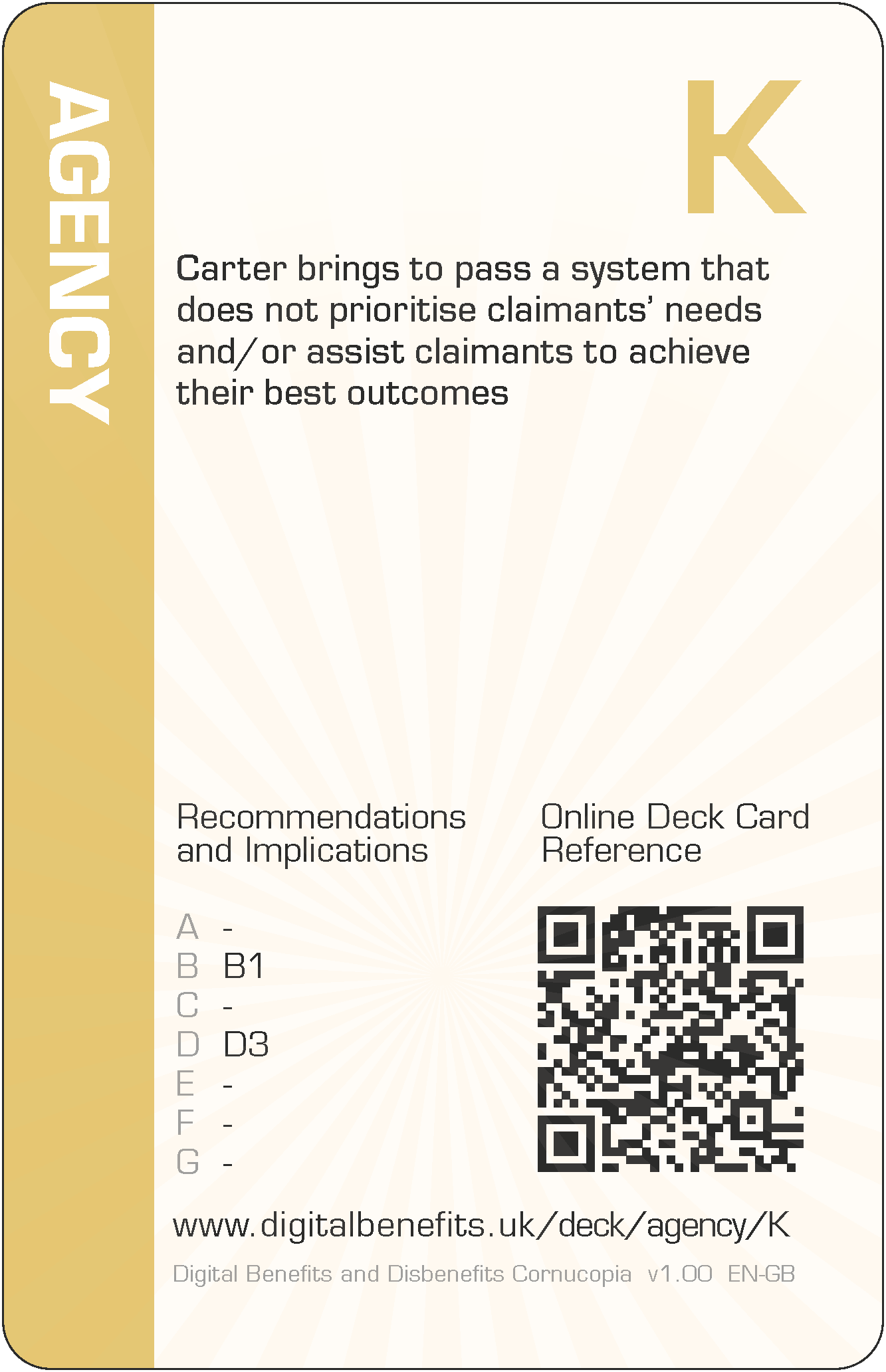Agency K (AG-K) Card
DBD Cornucopia > Deck > Agency > K
Card Details - King of Agency
Abbreviation
AG-K
Card's focus
The focus of this card is prioritising claimants' needs
Threat to claimants
Carter brings to pass a system that does not prioritise claimants' needs and/or assist claimants to achieve their best outcomes

Threat to claimants
Carter brings to pass a system that does not prioritise claimants' needs and/or assist claimants to achieve their best outcomes.
Some examples of how this threat could lead to harms (negative effects on claimants)
The design recommendations and implications relevant to the card are listed below in the next section, but even those can be somewhat abstract and difficult to think about during practical day-to-day implementation. Therefore, some example harms are provided to complement the more formal research outputs. These examples are unique per card, and are only published on these web pages (i.e. in no other project outputs).
- A lack of professional curiosity by government officials about claimants' vulnerabilities, and not using this knowledge to adjust the system and processes, puts claimants under immense mental pressure and affects their wellbeing
- Even when claimants are clearly uncertain what to do, government officials do not provide any suggestions or guidance, reducing their likelihood to make a successful claim
- The system fails to warn particular eligible claimants that they will be worse off financially if they claim, and instead make it the claimants' responsibility to determine this
- Claimants use the service to make contact and inform government officials they have changed job, but the claimants are not then asked for any additional details, and are later penalised for not providing their updated earnings
- The tone of communications with claimants is impersonal or robotic, leading to a lack of personal connection, increased claimant anxiety due to a feeling of a lack of understanding of claimants' individual needs, with consequent mistakes and errors undermining the accuracy of claims
- There are no fields in claimant records to identify what additional support needs, easements or other reasonable adjustments, leading to a lack of care when interacting with more vulnerable people, which makes claimants less able to make and maintain their awards and to do so healthily
The examples are to help understand the threat on the card, not to suppress thinking and innovation. Incorporating these examples exactly, or closely matching ones, should be scored down when playing DBD Cornucopia as a game.
Applicable design recommendations and implications
These are reproduced here from Research Briefing N
Acknowledge claimants as people in digital design
- Prioritise claimants' interests over system efficiencies
All digital welfare design processes, methods and decision-making should prioritise claimants' needs to achieve best outcomes for individuals rather than system efficiencies. Organisational knowledge and resources should be utilised to this respect including intervening in advance to identify matters that affect claims or what claimants may have forgotten about.
Embrace a wider ecosystem and fuller claimant activity viewpoint for digitised public services
- Use claimant-related policy outcome measures to assess digitisation
The most relevant factors of success of digital transformation are metrics based on the intended purpose of the policy rather than focusing on state-incurred financial costs. The advantages of digitised policy implementation must be balanced with the gains and harms across the whole ecosystem from the viewpoint of claimants.
General Notes
Card values (i.e. 'King' for this card) are for game play and are not correlated with the severity of harm. This is because threats cannot be ranked directly since they can affect individuals in different ways due to situations and circumstances, or affect fewer or more claimants, or the harms can arise in claimants' support networks and wider society.
The threat description uses a person's name as the "attacker" (i.e. 'Carter' for this card), which can be thought of someone involved with implementation. They could have any role which influence digitisation. So they could be a database administrator, or a copy writer, or a quality assurance specialist, etc, or all of these. Everyone could have some influence on the claimant threat described. The names were randomly selected from those currently most popular as given names for boys and girls (UK Office for National Statistics).
The example harms provided are drawn from the research data (which explored not only parts of existing services but also the effects of possible changes to those), from the author's own knowledge of web application development and testing, the author's own experience of helping citizens to claim Universal Credit (UC) and Personal Independence Payment (PIP), and from suggestions submitted by other people (make a suggestion). The threats and example harms do not necessarily exist in the current UC or PIP deployments or in ecosystems around those services, but they might well do.
All the cards in this Agency suit are: 2 3 4 5 6 7 8 9 10 J Q K A
The other suits in the deck are: Scope, Architecture, Trust, Porosity and Cornucopia (plus Jokers).
